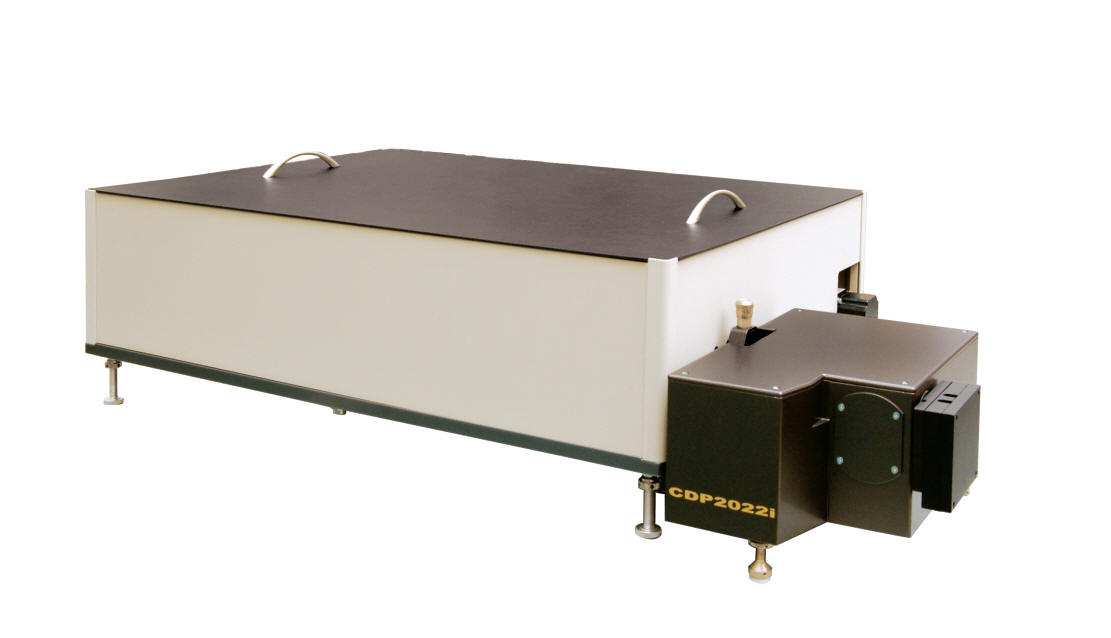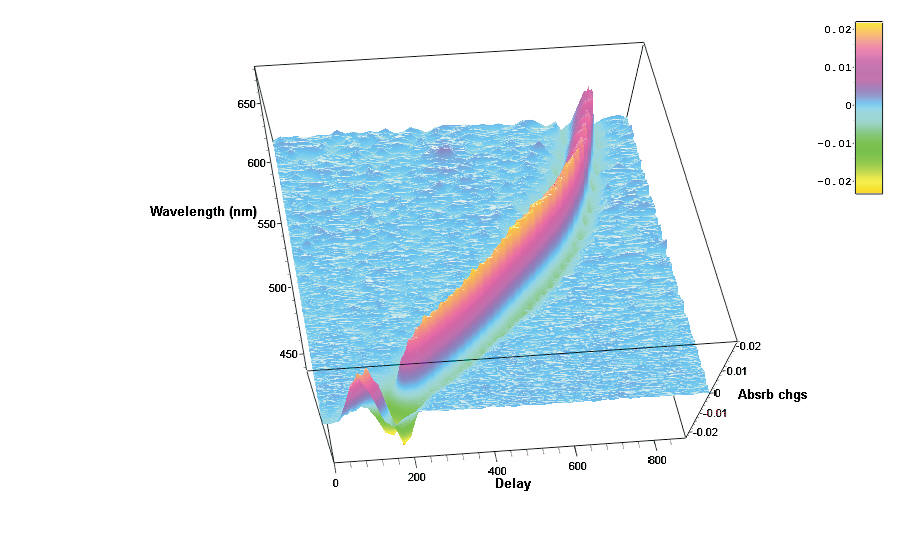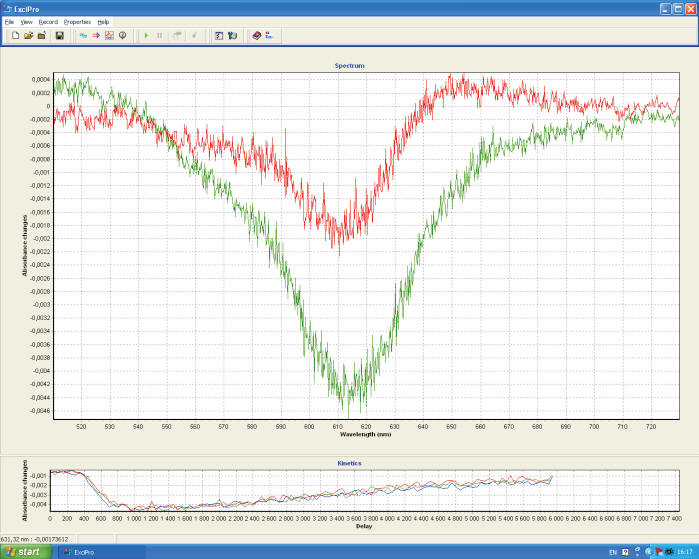
Del Mar Photonics - Hatteras brochure - Request a quote - Custom Femtosecond Transient Absorption Data Acquisition Systems
Below is a recent correspondence with prospective customer regarding using Hatteras ultrafast transient absorption system. The customer name is withheld.
Questions:
I contacted you recently enquiring about the Cannon broadband white light
generation. After Discussing it within our group and checking the
products
offered by Del Mar Photonics, we have decided to take a different approach and
buy an entire ultrafast transient absorption set up from you like the
Hatteras.
Let me start by describing our laser system, that we would use to pump the
Hatteras. We have a mode-locked Ti:sapphire laser (Mira, Coherent) and an
amplifier (Legend, Coherent) that can deliver 25mJ 1KHz 40fs 800nm pulses. We
also have 2 OPA systems that are pumped by this laser (Opera and Topas,
Coherent) that allow us to go with both pump and probe from 600 to 2500 nm. For
the kind of samples we are measuring we are mainly interested in the 900-2500nm
region.
What we would like to have from your company is a system like Hatteras that
would cover as much of that range as possible using broad-band white light
generation and diode array detection. This way we don't need to tune our OPA for
each point in the spectra.
For the Hatteras would mean:
- Extended range for WL generation. Changing the sapphire plate for something
else, like the technology used in the Cannon, or different pump wavelengths (we
can choose with our OPA) on a different material (like the utra-broad spectrum
shown by A. Saliminia et Al. Optics Express Vol. 13 No. 15 pg. 5731)
- Possibility for switching between white light or OPA for the wavelengths not
covered my the spectrum ( I think this is already standard in the system)
- Extended IR range for the detectors, using for example two-stage cooled diodes
and diode arrays from Hamamatsu (g9207 or g9208).
These are just the first ideas. We do like the Hatteras system because it has
what we have already plus some additions we are introducing in our system in a
compact design. But we find it a bit limiting in the wavelength range it can
handle.
Let me know your thoughts, I'm sure that together we can design a pretty unique
system (that would be also very interesting product for other groups in the
molecular electronics and nanoparticle world). Besides, we are building a fs
electron accelerator to be used also for pump-probe experiments; if this first
system is satisfactory we would buy a second one one to be used with the
accelerator (which should be pulsing this summer).
I Checked already the information in the link you
sent before, but I could not find there details about the white light generation
system. We do have already a working set-up covering 300-2500nm using OPA's. Our
main interest now is, due to the long time needed for data collection wavelength
by wavelength, to cover as much as possible of that range with a broadband
source and detection. Therefore our main question is, how far you think you can
go into the IR with the white light?
Answers:
Thank you for your further interest in Hatteras. Standard Hatteras configuration
contains two multichannel array detector heads: visible detector head covers
continuum up to 1000 nm, and InGaAs detector head covers spectral range from 900
nm to 1700 nm. We use detectors at room temperature. Cooled InGaAs arrays have
the same sensitivity as at room temperature, and they are used only for very
weak signals with very long accumulation time (1 s or more). At 1 kHz Hatteras
can accumulate up to 100 pulses before readout (0.1 s). It is usually enough to
detect continuum although we should check sensitivity around 1700 nm. Longer
accumulation leads to very long time for data collection. We also checked other
possibility. We tuned OPerA to 1420 nm, but the spectrum was broad enough. We
used it for probe within 1400 – 1500 nm and multichannel detection. I guess the
spectrum should be even broader at longer wavelengths and may be you don’t need
in continuum generation with OPA although I am thinking about that possibility
too.
Del Mar Photonics - Hatteras brochure - Hatteras Advantages - Eric Wei-Guang Diau publication

Figure 1. Optical layout of the femtosecond transient absorption
spectrometer. M1-M5, gold or aluminum mirrors; BS1 and BS2, beam splitters;
Wedge, wedge prism; B1, Berek compensator; WP, half-wave plate; Pl, polarizer;
L1 and L2, lens; AC1-AC4, achromatic lens; FC1 and FC2,
optical fiber couplers; PD, photodiode; R, retro-reflector. For single
wavelength measurements, the white-light (WL) cell was removed, and both
FC1 and FC2 were replaced with two photodiodes.
More Hatteras customers:
1. National Taiwan University, Taipei, Taiwan (Prof.
Pi-Tai Chou)
2. National Tsing Hua University, Hsinchu, Taiwan (Prof.
I-Chia Chen)
3. Toyota CRDL Inc., Aishi, Japan
4. Tokyo Metropolitan University, Tokyo, Japan
5. Osaka University, Osaka, Japan
6. International Laser Center, Bratislava, Slovak Republic
7. Institute of Physical Biology, Nove Hrady, Czech Republic
8. Institute of Spectroscopy, Troitsk, Russian Federation
9. Nanoparticle Manufacturing
Laboratory, University of Leeds, Leeds, UK - Yasir Khan Technician
y.khan@leeds.ac.uk
10. University of Joensuu, Joensuu, Finland
11. Universidad de Castilla-La Mancha, Toledo, Spain
12. School of Chemistry, North-West University,
South Africa - Christien A Strydom
E-mail us to receive complete contact details of our Hatteras customers
Hatteras Specifications (pdf):
Hatteras femtosecond transient absorption
pump-probe system:
Input requirements: > 0.5 mJ at 800 nm, < 100 fs, 1 kHz
1. All optics and mechanics for pump – probe measurements, assembled on a
breadboard with cover box: femtosecond white light (continuum) generator for
probe and reference pulse formation at 400 – 1600 nm; 2.0 -ns optical delay
line; transmission and reflection configurations; optics for fluorescence
anisotropy measurements; rotating sample cell assembly; holder for solid samples
and thin films; set of selected color and neutral density filters.
2. Multi channel detector head, with two 1024-pixels extra-deep well NMOS linear
image sensors, 200 -1000 nm spectral response (10% of peak), > 5800 dynamic
range, up to 1 kHz readout rep. rate
3. Hatteras 2022i imaging spectrometer, adapted to the detector head and
connected to a computer via serial port:
4. Photodiode for the system synchronization
5. Photodiode for pump power measurements
6. Synchronized chopper
7. Hatteras 3.0 data acquisition, chirp correction, 3D and kinetic analysis
software
Infrared multichannel detector head (option), with two 256-pixels InGaAs linear
image sensors, 100 -1700 nm spectral response (10% of peak), > 5800 dynamic
range, up to 1 kHz readout rep. rate
Standard Hatteras quote based on US
Domestic list price. Add 10% for International quotes.
E-mail us for a custom quote
Main advantages of Hatteras pump-probe (transient absorption) spectrometer:

1. We use pump-probe configuration, where two signals (probe and reference) are
measured by two linear image sensors. This configuration is very important for
precision optical density changes (ΔOD) measurements, because one can get
results independent on probe beam fluctuations. Calculation of probe to
reference ratio is the key principle of the pump - probe method. To our
knowledge, probe beam only without reference one is used by other pump-probe
systems, and device
sensitivity in this case is seriously limited by probe beam stability.

2. Two linear image sensors of Hatteras are placed in the focal plane of high
quality imaging spectrometer with four-grating turret to provide automatic
grating switching. Two standard gratings are installed to cover 330 nm – 1700 nm
spectral range with 206 nm detection range. A central wavelength of the
detection range is computer controlled. Two other gratings are available
optionally on the customer’s choice and request. To our knowledge, simple
spectrometer, configured for one fixed spectral range and equipped with one
sensor, is used by other pump-probe systems. We use spectrometer specially designed for pump-probe
measurements.
3. Hatteras CDP2022C imaging spectrometer has two outputs. Multichannel detector head is
mounted on the first one, and the second one is for optional single channel
detector head, containing two (probe and reference) photodiodes. This single
channel option is important for high quality transient absorption kinetics
measurements at given wavelength. Because of larger photo detector area and
larger detector dynamic range, single channel system usually gives better ΔOD
sensitivity than multichannel one (both systems use probe and reference beams).
Other pump-probe systems do not offer this option.
4. We offer:
• Si multi channel head (200 nm – 1000 nm),
• InGaAs multi channel head (900 nm – 1700 nm),
• Si single channel detector head (320 nm – 1060 nm, 190 nm – 1100 nm on
request)
• InGaAs single channel head (900 nm – 1700 nm, 900 - 2000 nm on request)
• CdHgTe (1 m - 17 m) single channel head
Hatteras is a modular system. If you order visible multi channel head as a basic
one, in future you can order other heads and connect to your control unit. One
multi channel and two single channel heads can be connected to the control unit
simultaneously.
Other pump-probe systems do not offer these possibilities.
5. Hatteras-T kit of optical and mechanical components is flexible to satisfy
user’s requirements. For example, a configuration with two single channel heads
is used for single scan anisotropy kinetic measurements (both kinetics are recorded
simultaneously for parallel and perpendicular polarization). To our knowledge,
other pump-probe spectrometers do not realize many configurations available in
Hatteras.
6. Hatteras configurations give possibilities to direct probe and reference beams
to the entrance slit of the monochromator fiber coupling or directly
(free-space).
First method is simpler. Second method requires more precise adjustments, but
gives better S/N, especially in UV region. To our knowledge, fiber coupling only is
used by other pump-probe systems.
7. Hatteras offer many sample holder options including specially designed
rotation cell. It gives a
possibility of “pseudo single-shot experiment”, when every pulse at 1 kHz hits a
fresh sample. To our knowledge, only single sample holder such as shaking sample cell only is used by
other pump-probe systems. It
is simplest solution and we used that approach 20 years ago…
8. Linear image sensors with 1024 pixels (sensitive at 200 nm – 1000 nm) are
used in the Hatteras. To our knowledge, other
pump-probe systems use sensor with 512 pixels.
9. Extra-deep well photodiode linear image sensors are used in the
Hatteras. These sensors were specially designed for
photometric applications like transient absorption pump-probe experiments where
very small signal changes should be detected. CCD detectors used in other
pump-probe systems are not photometric devices
and give less S/N.
10. 2. 0 ns delay line with 0.78125 min step is used in the Hatteras. 1.6 ns
delay line with 3.5 fs min step is used in other pump-probe systems.
11. Pump pulse energy is measured for every pulse (special photodiode is used
for this purpose). Pump pulse margins or normalization can be applied for
further S/N improvement.
12. CDP2017 frequency conversion option (optical parametric amplifier with
frequency mixing and second harmonic) was specially designed to make pump beam
easy tunable in 480 nm – 800 nm spectral range. Although one can use other
optical parametric amplifiers, CDP 2017 gives cheaper solution and better
matching with Hatteras.
13. Alternatively, TOPAS from Light Conversion (Lithuania) or OPerA Solo from
Coherent is recommended as a computer controlled OPA operated with
Hatteras ExciPro
software.
14. Our data sheet demonstrates well resolved transient absorption peak of
0.0003 OD and corresponding noise is less than 0.0001 RMS. Although other
pump-probe systems claim 0.0002 OD noise, all available data sheets show one and the same
spectrum where scale for the optical changes is not shown.
15. Hatteras ExciPro software makes user friendly data
acquisition, chirp correction and some procedures for instant data analysis. On
the other hand, obtained 3D spectra can be easy exported to various special data
analysis software like Mathematica, Origin, Femtoscan, or Surface Xplorer.
E-mail us to discuss custom software package.

16. Hatteras optical unit together with the spectrometer is more compact than
other pump-probe systems optical unit, although we use probe – reference scheme, rotating sample
cell, Berek’s wave plate assembly and other components which are not used in
other systems.
18. Hatteras has been designed by ultrafast dynamics veterans in 1999 – 2000 for precision
measurements of small photo induced optical density changes (ΔOD) in wide
spectral range. Using our own many years experience in pump-probe experiments,
as well as experience of leading laboratories, all components were specially
designed, selected, and tested to make state-of-the-art system with best
specifications. Hatteras is first femtosecond transient absorption spectrometer
on the market.

Standard Hatteras quote based on US
Domestic list price. Add 10% for International quotes.
E-mail us for a custom quote
Related Del Mar Photonics product brochures
Femtosecond Lasers
Trestles femtosecond Ti:Sapphire laser
Trestles Finesse femtosecond
Ti:Sapphire laser with integrated DPSS pump laser
Teahupoo Rider femtosecond amplified
Ti:Sapphire laser
Mavericks femtosecond
Cr:Forsterite laser
Tamarack femtosecond fiber laser (Er-doped
fiber)
Buccaneer femtosecond OA fiber laser (Er-doped
fiber) and SHG
Cannon Ultra-broadband light source
Tourmaline femtosecond Yt-doped fiber laser
Chata femtosecond Cr:ZnSe laser (2.5 micron) coming soon
High Power Femtosecond Laser Systems
Cortes 800 tabletop 40 TW
Ti:Sapphire laser system
Cortes E - High vacuum
laser ablation/deposition system with 2 TW Ti:Sapphire laser
Cortes K - femtosecond seed laser
for Petawatt KrF excimer laser
Cortes O 200TW femtosecond laser - KD*P CPOPA based
amplifier system
Jaws femtosecond Cr:forsterite
Multi-Terawatt Amplified Laser
High-vacuum system for laser
ablation/deposition
Femtosecond pulse measurement instrumentation
Reef scanning and single shot
femtosecond autocorrelators
Avoca SPIDER
Spectral phase interferometry for direct electric-field reconstruction (SPIDER)
Rincon third order femtosecond
cross-correlator (third order autocorrelator TOAC) also referred to as
contrastmeter
Ultrafast Dynamics Research Tools
Beacon femtosecond fluorescence up-conversion (optical gating) spectrometer
Femtosecond Systems and Accessories
Femtosecond Micromachining
Femtosecond nanophotonics
Femtosecond NSOM
Pacifica femtosecond fiber laser based
terahertz spectrometer
Pismo pulse picker (ultrafast
electro-optical shutter)
Wavelength conversion:
second and third harmonics generators for femtosecond lasers
Jibe white light continuum generator
Kirra Optical Faraday Rotators and
Isolators
Laser accessories
Diffractive Variable Attenuator for high power lasers
Deformable mirrors - active
elements for adaptive optics systems
ShaH - the family of fast,
accurate and reliable wavefront sensors
Complete adaptive optics systems
Faraday rotators and isolators for high-power
(up to 1kW) laser beams
SAM - Saturable Absorber Mirrors
Lithium Niobate Q-switches
Lithium Tantalate Q-switches
Optics from A to Z
BBO (Beta Barium Borate) crystals